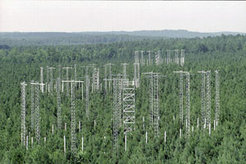The ‘why’ of models

Predicting how forests will respond to increased levels of atmospheric carbon dioxide involves understanding the interplay among carbon dioxide, nutrients, water, plant, and soil processes. This multitude of variables challenges scientists who are trying to gauge how future ecosystems will react in a changing climate.
Recently, an international team of researchers from Australia, the United States, the UK, and Germany around Sönke Zaehle, group leader at the Max Planck Institute for Biogeochemistry set out to assess how free air CO2 enrichment experiments in young forest ecosystems compare to eleven vegetation models that simulate various ecological processes. The team summarized its work in a study published in Nature Climate Change.
Instead of only identifying whether or not an individual model matched the experimental data, the researchers developed an “assumption-centered” approach to evaluate why certain models perform better than others. “We wanted to understand why the models are doing what they are doing, rather than just comparing the models to the data in a more superficial fashion,” said Sönke Zaehle. “By understanding the processes that are responsible for what’s going on in the models, weare connecting them with the experiments in a common language,” he continues.
Belinda Medlyn, Professor at the University of Western Sydney adds that this type of collaborative approach is increasingly important in climate change science, where field researchers and modeling experts are working together more closely than ever before. Comparing the models to the FACE data sets (Free-Air CO2 Enrichment) allowed the team to identify missing or wrong assumptions in the models and pinpoint processes where additional data are needed, thereby providing a roadmap for future development of models, as well as new experiments.












